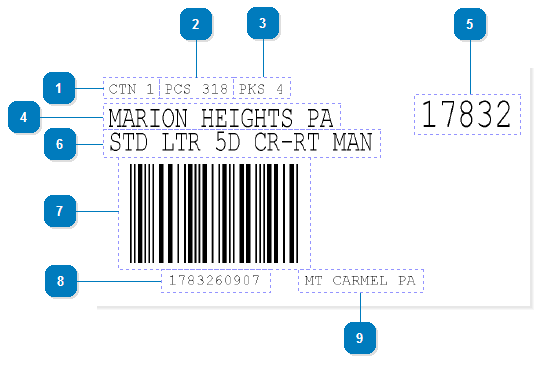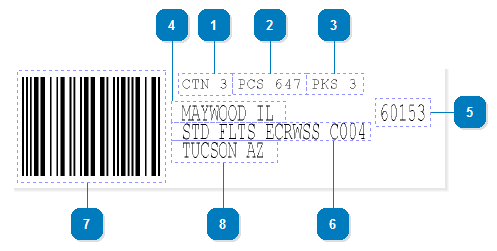
Tray and Sack Tags
To qualify for postal discounts, presorted mail must be presented to the post office in either a tray or a postal sack, depending on the type of mailing. In ListAbility Online presort, all letters go in a tray, while sacks are used for flats. Each tray must bear a correct tray tag (label); each sack must bear a correct sack tag (label). ListAbility Online provides tags in compliance with the USPS standards.
The size of the tray tag is 2 inches by 3.25 inches. Standard printer paper size contains 10 tags per page.
Tray tags consist of the following elements:

Items (1), (2), (3) make an Extraneous Information Line, which indicates the following:
A. The container number (tray number).
B. The number of pieces in the tray, in this instance the tray has 318 letters.
C. The number of packages in the tray.
The second line including items (4), (5) is the Destination Line, which indicates the post office that will receive the tray.
D. City and 2-letter state abbreviation.
E. ZIP code for the post office.
F. The Content Line showing the class, processing category and the sortation level of the mail in the tray and other information as specified by standards. In other words, it indicates the type of postal presort for the mail contained in the tray. The information is presented in codes. In this instance the break out will be: STD LTR—Standard Letter, 5D—5 Digit, CR-RT—Carrier Route, Man—Manual Presort.
G. The Barcode representing three numeric elements:
a A 5-digit ZIP Code destination of the tray. For a 3-digit tray destination, the 3-digit ZIP Code prefix is followed by two zeros.
b A 3-digit content identifier number (CIN) for the tray.
c A 2-digit USPS processing code.
H. The Barcode Numeric Line consisting of a numeric representation of the information contained in the barcode. This way if the scanner cannot read the barcode, the post office can enter the number manually.
I. The Origin Line showing the city and abbreviated state of the entry post office.
Tray tags only can contain another piece of information—Zebra Code, which is a series of diagonal marks to the right of the barcode that serves as a visual indication that a tray contains automation rate mail.
The size of the sack tag is 1 inch by 3.25 inches. Standard printer paper size contains 20 tags per page.
Sack tags consist of the following elements:

Items (1), (2), (3) make an Extraneous Information Line, which indicates the following:
A. The container number (sack number).
B. The number of mail pieces in the sack, in this instance the sack has 647 flats.
C. The number of packages in the sack.
The second line including items (4), (5) is the Destination Line, which indicates the post office that will receive the sack.
D. City and 2-letter state abbreviation.
E. ZIP code for the post office.
F. The Content Line showing the class, processing category and the sortation level of the mail in the sack and other information as specified by standards. In other words, it indicates the type of postal presort for the mail contained in the sack. The information is presented in codes. In this instance the break out will be: STD FLTS—Standard Flats, ECRWSS—Extended Carrier Route Walking Sequence Saturation, C004—one-letter carrier route type description followed by a 3-digit route number.
G. The Barcode representing the following information: a 5-digit ZIP Code destination of the sack (for sacks with a 3-digit destination, the 3-digit ZIP Code prefix is followed by two zeros); and a 3-digit content identifier number (CIN).
H. The Origin Line showing the city and abbreviated state of the entry post office.